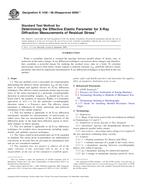Potřebujeme váš souhlas k využití jednotlivých dat, aby se vám mimo jiné mohly ukazovat informace týkající se vašich zájmů. Souhlas udělíte kliknutím na tlačítko „OK“.
ASTM E1426-98(2009)e1
Standard Test Method for Determining the Effective Elastic Parameter for X-Ray Diffraction Measurements of Residual Stress (Includes all amendments And changes 2/27/2015).
Automaticky přeložený název:
Standardní zkušební metoda pro stanovení efektivní Elastic parametrem pro rentgenová difrakce Měření zbytkových napětí
NORMA vydána dne 1.6.2009
Informace o normě:
Označení normy: ASTM E1426-98(2009)e1
Poznámka: NEPLATNÁ
Datum vydání normy: 1.6.2009
Kód zboží: NS-41723
Počet stran: 5
Přibližná hmotnost: 15 g (0.03 liber)
Země: Americká technická norma
Kategorie: Technické normy ASTM
Anotace textu normy ASTM E1426-98(2009)e1 :
Keywords:
elastic parameter, residual stress, x-ray diffraction, Crystal lattice structure, Effective elastic parameter (Eeff), Macroscopic analysis, Polycrystalline materials, Residual stress, Stress--metallic materials, X-ray diffraction analysis, ICS Number Code 71.040.50 (Physicochemical methods of analysis)
Doplňující informace
| Significance and Use | ||||||||
|
This test method provides standard procedures for experimentally determining the effective elastic parameter for X-ray diffraction measurement of residual and applied stresses. It also provides a standard means of reporting the precision of the parameter. This test method is applicable to any crystalline material which exhibits a linear relationship between stress and strain in the elastic range. This test method should be used whenever residual stresses are to be evaluated by an X-ray diffraction technique and the effective elastic parameter of the material is unknown. |
||||||||
| 1. Scope | ||||||||
|
1.1 This test method covers a procedure for experimentally determining the effective elastic parameter, Eeff, for the evaluation of residual and applied stresses by X-ray diffraction techniques. The effective elastic parameter relates macroscopic stress to the strain measured in a particular crystallographic direction in polycrystalline samples. Eeff should not be confused with E, the modulus of elasticity. Rather, it is nominally equivalent to E/(1 + ν) for the particular crystallographic direction, where ν is Poisson's ratio. The effective elastic parameter is influenced by elastic anisotropy and preferred orientation of the sample material. 1.2 This test method is applicable to all X-ray diffraction instruments intended for measurements of macroscopic residual stress that use measurements of the positions of the diffraction peaks in the high back-reflection region to determine changes in lattice spacing. 1.3 This test method is applicable to all X-ray diffraction techniques for residual stress measurement, including single, double, and multiple exposure techniques. 1.4 The values stated in inch-pound units are to be regarded as standard. The values given in parentheses are mathematical conversions to SI units that are provided for information only and are not considered standard. 1.5 This standard does not purport to address all of the safety concerns, if any, associated with its use. It is the responsibility of the user of this standard to establish appropriate safety and health practices and determine the applicability of regulatory limitations prior to use. |
||||||||
| 2. Referenced Documents | ||||||||
|
Odebírejte informace o nově vydaných normách ZDARMA:
Chcete pravidelně odebírat informace o nově vycházejících normách z celého světa a to zcela zdarma?
Přihlašte se k odběru. Vše je velice jednoduché a absolutně ZDARMA.
Na výběr máte vydavatele z celého světa.




 Cookies
Cookies
